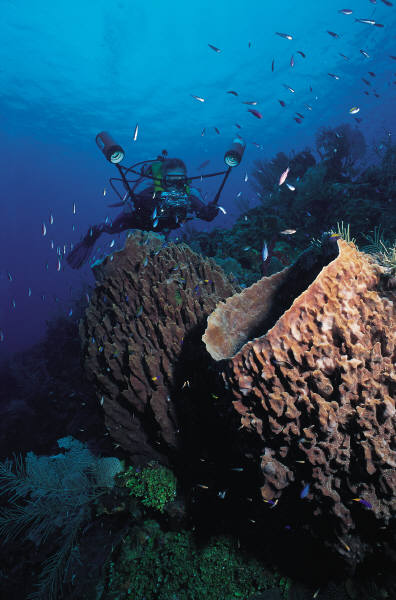Invertebrate
Zoology Porifera
 |
Phylum
Porifera
1. Characteristics: multicellular, no tissues or organs, mostly marine, sedentary suspension feeders (they feed by filtration).
2.
Asymmetrical or radially symmetrical
4.
Cells specialized (dedicated to one
or a few functions); four cell types: pinacocytes,
archeocytes (amoeboid cells), choanocytes, and porocytes (porocytes are specialized pinacocytes)
5.
Central cavity (spongocoel), or a series of branching
chambers, through which water circulates during filter feeding
6.
Have
both protozoan and metazoan (all animals except porifera) characteristics
|
Sponges are the most ancient animals, and, thus, are the basal branch of the Animalia (see cladogram). An early branching event in the evolution of animals separated the sponges from other metazoans.They date back to 580 million years, making sponges the oldest known animals. Natural selection favored body plans with increased surface area, giving rise over time to increasing complexity of body architecture: ascon, sycon, and leucon are levels of complexity that grade one into the other. The earliest sponges were very simple in body form similar to the ascon sponges of today. The vast majority of sponges are of the leucon body type.
Various canals, chambers, and cavities enable water to move through the sponge to allow the exchange of food and gases and to remove waste. They feed by filtering bacteria from the water that flows through their bodies; some sponges trap ~90% of all bacteria in the water they filter. Glass sponges are less efficient at capturing bacteria and specialize in feeding on small bits of organic material. Other sponges have symbiotic relationships with dinoflagellates or cynobacteria, from which they also derive nutrients. Water currents are actively generated by the beating of flagella. Water enters through tiny pores called ostia (porifera means "pore bearing"), flows through canals to a chamber (spongocoel), or, in more complex sponges, through a canal system and then into the spongocoel; water exits through a large opening called an osculum.
Sponges have significant ecological importance in various marine ecosytems. The volume of water passing through sponges can be enormous, helping reduce the turbidity of coastal water. Sponges provide habitat and shelter for a wide range of organisms and protect coral reefs from extreme fluctuations in nutrient density/temperature/light.
Sponges have a cellular level of organization. Cells of different types carry out the activities that sustain life. 1) Pinacocytes are flattened cells that form the outer layer of the sponge; they give the animal shape and provide protection; 2) Choanocytes have a central flagellum surrounded by a collar ("collar cells") and they are virtually identical to the choanoflagellates (a colonial flagellate), which suggests that sponges and choanoflagellates are closely related and likely share common ancestry. Choanocytes create currents that pull in water carrying suspended food particles; 3) Archaeocytes (amoebocytes) are the most generalized cell type that patrol the gelationous, middle mesohyl layer, These amoeboid-like cells have a number of functions: they ingest and digest food caught by the choanocytes and transport nutrients to the other cells in the sponge; they form the spicules and gametes (sperm and egg); 4) Porocytes are elongated donut-shaped cells that surround canal openings; they are specialized pinacocytes that have the ability to contract, which regulates water flow through the sponge.
Spicules (and spongin) are the skeletal elements of sponges and are secred by archaeocytes. Spicules are composed of mineralized substances such as calcium carbonate and silicon dioxide. Other sponges, such as "bath" sponges, secrete a organic (proteinaceous) material called spongin.
Sponges reproduce both sexually and asexually. Sponges that reproduce sexually are monecious but avoid self-fertilization by timing gamete production. Sperm are "broadcast" into the water column where they are captured by the choanocytes of another sponge and transported to the eggs by amoeboid cells. Fertilization occurs in the mesohyl where the zygotes develop into free-swimming ciliated larvae and pass out of the osculum. The larvae swim away from the parent, settle, and metamorphose into adult sponges. Some sponges that reproduce asexually produce buds or, more often, gemmules. Gemmules are common for freshwater sponges; they allow the sponge to survive adverse environmental conditions.
Return to the Invertebrate Zoology
Homepage.